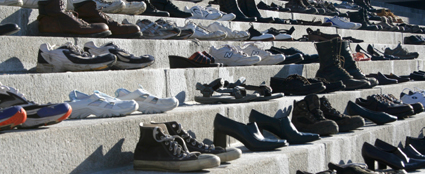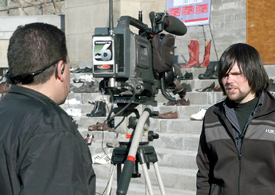
|
CONNECTIONS
|
IDAHO
ITD
HOME
IDAHO DMV
ITD
NEWS
HIGHWAY
SAFETY
IDAHO STATE
POLICE
TRAVEL SERVICES
STATE OF IDAHO
NATIONAL
AASHTO
AAMVA
AAA of IDAHO
FEDERAL HIGHWAYS
FEDERAL AVIATION
IDAHO STATE POLICE
NHTSA
NTSB
TRB
U.S. DOT
Idaho
Transportation
Department
Public Affairs Office
P.O. Box 7129
Boise, ID 83707
208.334.8005
Fax: 208.334.8563
Email


Traveling
display illustrates human,
economic toll of not wearing seat belts
Serving as a silent reminder of lives lost in 2005 as a result of not wearing seat belts, 126 pairs of shoes were put on display on the Idaho Capitol steps Wednesday (Jan. 24) by the Idaho Seat Belt Coalition.
The Boise stop was part of a weeklong journey throughout the state for the coalition’s “Empty Shoes” display that began Monday (Jan. 22) in Coeur d’Alene and concludes today (Jan. 26) in Idaho Falls and Pocatello.
Along the way, representatives from the coalition spoke at each stop about the need for all Idahoans to buckle up.
 Dave
Carlson, coalition co-chair, told a crowd of about 60 people that 87
pairs of the shoes represented unbelted males ages 13 and older. “That
is 70 percent of the pairs of empty shoes,” he said.
Dave
Carlson, coalition co-chair, told a crowd of about 60 people that 87
pairs of the shoes represented unbelted males ages 13 and older. “That
is 70 percent of the pairs of empty shoes,” he said.
Joining Carlson to talk about the costs in money and lives associated with choosing to not wear a seat belt were Capt. Ben Wolfinger, with the Kootenai County Sheriff’s Office, ITD’s Mary Hunter, St. Luke’s Regional Medical Center Director Sherry Iverson and Craig Lough, a 2003 crash survivor.
“The 20 percent of Idahoans that do not buckle up account for 60 percent of the people killed in traffic crashes,” Wolfinger said.
Hunter talked about how Idaho is no longer receiving the kind of federal funds that helped increase seat belt usage in the state from 58 percent in 1999 to 80 percent today.
“Idaho is no longer eligible to receive seat belt incentive funds because our seat belt laws do not meet the minimum standards established by Congress,” she said, adding that all but 13 states currently receive those funds.
“Seat belts, when used, are the most effective safety feature ever introduced for vehicles, cutting the likelihood for fatal and serious injuries in half,” said Iverson.
 “While
the injured person pays 15 percent of the medical bill, we pick up the
rest of the tab, paying 85 percent of the medical bills associated with
those injuries,” she said. Iverson cited higher insurance premiums,
taxes and increased charges for medical services as costs passed on
to society.
“While
the injured person pays 15 percent of the medical bill, we pick up the
rest of the tab, paying 85 percent of the medical bills associated with
those injuries,” she said. Iverson cited higher insurance premiums,
taxes and increased charges for medical services as costs passed on
to society.
Unbelted deaths and serious injuries cost Idahoans $575 million in 2005, according to the coalition.
Crash survivor Craig Kough told the crowd that he was lucky to be speaking to them instead of being a casualty statistic. In 2003 he lost control of his car on a slippery road, and it rolled five times.
“My seat belt saved my life and saved my family a great deal of agony,” he said
Photo caption: Empty shoes (top) represent the loss of 126 individuals who died as a result of not using seat belts in 2005 . Among the crash survivors who credits seat belts with saving his life was Craig Kough, interviewed by a Boise-area television reporter Wednesday (middle). The crowd assembled for the news conference included a contingent of motorcycle officers (bottom).
Published 1-26-07